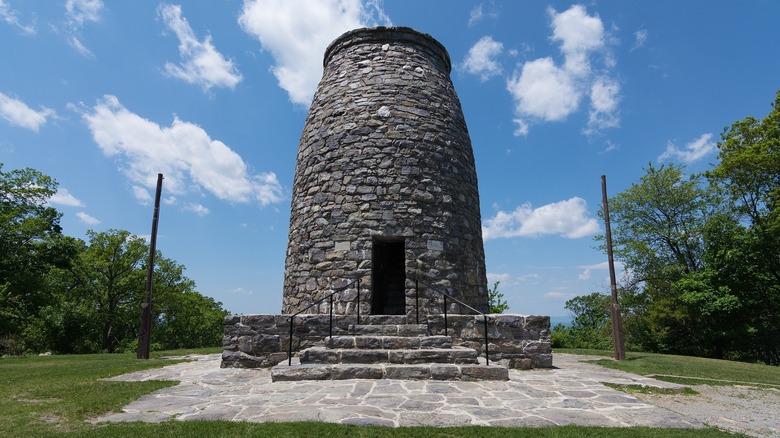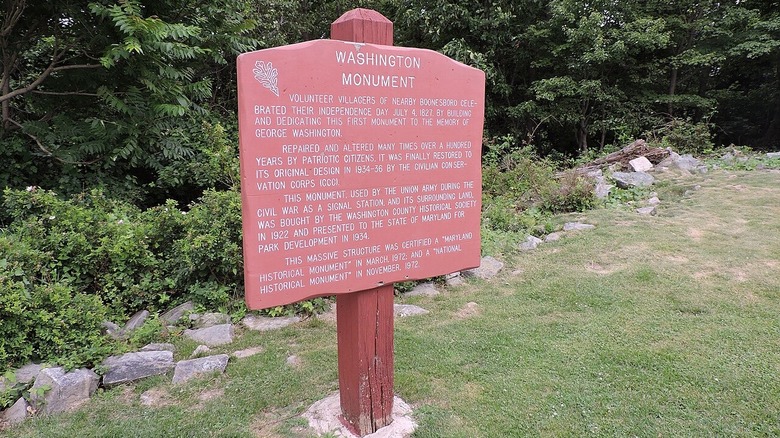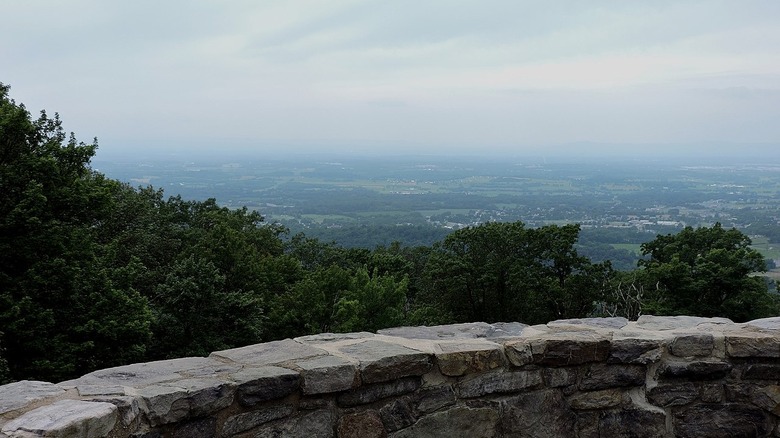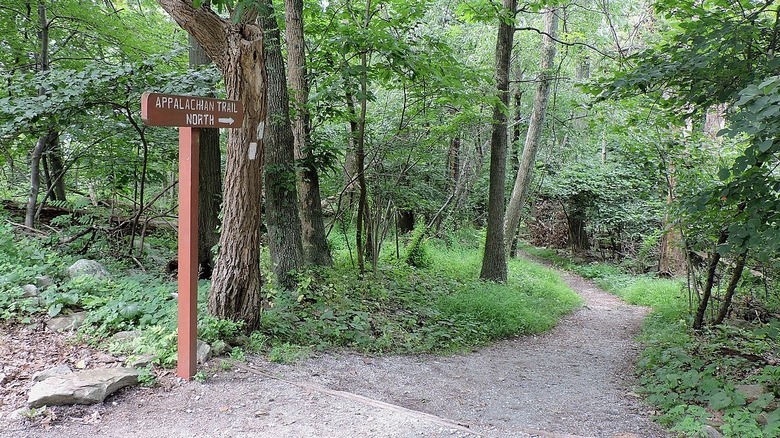The Real Story Behind The First Washington Monument
So everyone knows the Washington Monument, right? It's that 30-foot-tall, milk bottle-shaped structure made of gray stone blocks that, uh ... Well, there's really nothing else to the thing. Ok, it's got a door. And there's a dedication on a plaque that reads, "Erected in memory of Washington, July 4, 1827, by the citizens of Boonsboro," as we can read on Atlas Obscura. Oh, you mean the big, tall, thin, white Washington Monument modeled after Egyptian obelisks that sits on the National Mall in Washington, D.C. across that long, rectangular pool from the Lincoln Memorial? Right. Well, funny story: That's actually the United States' second Washington Monument. The other one — the milk bottle one — is the nation's original, and modest, edifice built in honor of George Washington.
So yes, back in 1827 some very enthusiastic citizens of Boonsboro, Maryland took it upon themselves to build the United States' very first monument to the country's very first president. Brimming with "patriotic purpose" and propelled by "a spirit of zeal and ardor," as Smithsonian Magazine quotes local paper Torch Light, these fervent few dragged stone blocks up to the top of a 1,500-foot hill southeast of their little town of Boonsboro. As the National Parks Conservation Association says, some of the stones weighed over a ton. Originally only 15 feet tall and built without mortar, the monument fell apart by 1861, got rebuilt, blasted by lightning (or dynamite), rebuilt again, and eventually its land became a state park.
[Featured image by Patorjk via Wikimedia Commons | Cropped and scaled | CC BY-SA 4.0]
A humble monument voluntarily built
For such a small and unassuming structure, the Washington Monument sure has had a colorful, dramatic, and explosive — literally — life. As the National Parks Conservation Association says, the whole construction took three months split over a mere two days. It was completely self-initiated, non-government-overseen, and by all accounts done in a "celebratory spirit." Volunteers wore "patriotic clothes," and, to complete the effect, hauled and lifted stones to the music of an accompanying "drum and fife corps" that tooted and pattered "spirited music." Everyone marched and hefted along the two-mile hike to the top of South Mountain, which connects to the Appalachian Trail.
Smithsonian Magazine says that a senior church leader led the dedication to the monument at about noon on July 4, Independence Day, 1827. Folks read the Declaration of Independence, and three veterans from the Revolutionary War fired off some commemorative rounds. In fact, the milk bottle shape of the monument was supposed to resemble a Revolutionary War cannon. "As it was raised in much haste, we cannot boast the regular accuracy of perfect beauty, yet it possesses both solidity and durability," local William Bell wrote of the monument, per Atlas Obscura. "It has such strength as I think will preserve it for ages." The monument has indeed persevered in the intervening 200 years, but not without some hiccups along the way. By the time Confederate General Robert E. Lee came across it in 1862, it was already in ruins.
[Featured image by lcm1863 via Wikimedia Commons | Cropped and scaled | CC BY-SA 2.0]
Signal tower and detonation site
Smithsonian Magazine says that when Robert E. Lee made his "hard, hot climb" up South Mountain during its self-named Battle of South Mountain, he thought the ruins of the Washington Monument were supposed to be a windmill — apparently the monument wasn't too well known 40 years after its creation. Over the course of the Civil War, the Maryland Department of National Resources says that the monument's hilltop was a signal tower where soldiers used a "Wig Wag" system of right-left flag flaps to send messages in binary 1s and 0s.
It took another 20 years for the Independent Order of Odd Fellow — an 1819-founded, independent, nationalistic fraternal order — to rebuild the monument. The Maryland Department of National Resources says that the Odd Fellows ran a public fundraiser to get enough money to restore the monument to its "former glory." As Smithsonian Magazine recounts, they even painted it white and added an observation tower before rededicating it to an audience of 5,000 people.
The monument's renewed glory, however, didn't last long. It's unclear exactly what happened, but in 1906 the Baltimore Sun reported that lightning had struck the monument, and half of it collapsed. However, a local farmer suspected that a teenage prank was to blame when his daughters went out with a couple of dynamite-packing boys, per Smithsonian. One more round of dynamite in 1916 — apparently done for the sake of further lawless amusement — blasted apart the monument even more.
[Featured image by lcm1863 via Wikimedia Commons | Cropped and scaled | CC BY-SA 2.0]
State park and hiking destination
The final chapter of the United States' first Washington Monument started in the early 20th century during the Great Depression. After laying in apparent lightning and/or dynamite-caused rubble for years, Smithsonian Magazine says that the Washington County Historical Society (WCHS) bought the monument and a one-acre piece of land around it in 1922, seemingly just for the purpose of preservation and restoration. In 1927, two humble citizens commemorated the 100-year anniversary of the site's original dedication by hiking to the monument and putting a flag and wreath next to what was then a veritable pile of stones.
Come 1934, some more self-initiated, helpful people stepped in to buy the monument's land plus an additional 10 acres around it, per Smithsonian Magazine. They then gave it to the State of Maryland, which made it into a state park. By 1936, the monument had been rebuilt, and by 1972 — over 150 years after its creation — was added to the National Park Service's National Register of Historic Places.
At present, folks wishing to visit this very hardy piece of symbolic architecture can intercept it through the Appalachian Trail, or make the drive out to the Boonsboro, Maryland area and hike the two-mile trail to the top of South Mountain. Per Only in Your State, there's a little spiral staircase inside the monument — just like its taller, slenderer cousin in Washington D.C. — that lets visitors see all the way to West Virginia.
[Featured image by lcm1863 via Wikimedia Commons | Cropped and scaled | CC BY-SA 2.0]



